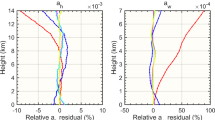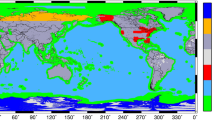Abstract
The Korea Meteorological Administration (KMA) has processed the data from the advanced TOVS (ATOVS) onboard NOAA-16 satellite since May 2001. The operational production utilizes the AAPP (ATOVS and AVHRR Processing Package) of EUMETSAT and IAPP (International ATOVS Processing Package) of the University of Wisconsin. For the initial guess profiles, the predicted fields (usually 6 to 12 hour forecasted fields) from the global aviation model of NOAA/NCEP are used. The average number of profiles retrieved from the ATOVS data is about 1,300 for each morning and afternoon orbit at about 18 and 06 UTC, respectively. The retrieved temperature and dew point temperatures are provided to forecasters in real time and used for initialization of prediction models. With the advanced microwave sensor (AMSU; Advanced Microwave Sounding Unit), accuracy of the ATOVS products is expected to be better than that of the TOVS products, especially in cloudy conditions. Indeed, the preliminary results from a validation study with the collocated radiosonde data during a 8-month period, from May to December 2001, for the East Asia region show an improved accuracy of the ATOVS products for cloudy skies versus the TOVS, especially for higher altitudes. The RMS (Root Mean Square) difference between the ATOVS products and radiosonde data is about 1.3°C for both clear and cloudy conditions, except for near the ground and at higher altitudes, at around 200 hPa. There is no significant temporal variation of the error statistics at all pressure levels. In case of the water vapor mixing ratio, the largest difference is shown at lower altitudes, while the accuracy is much better for the clear sky cases than the cloudy sky cases. The bias and RMSE at lower altitudes is about 0.557 g kg−1 and 2.5 g kg−1 and decrease significantly with increasing altitude.
Similar content being viewed by others
References
Barcilon, V., 1975: On Chahine’s relaxation method for the radiative transfer equation.J. Atoms. Sci.,32, 1626–1630.
Chahine, M. T., 1968: Determination of the temperature profile in an atmosphere from its outgoing radiance.J. Opt. Soc. Amer.,58, 1634–1637.
Chahine, M. T., 1970: Inverse problems in radiative trans-fer: A determination of atmospheric parameters.J. Atmos. Sci,27, 960–967.
Chung, H. S., and Y. S. Lee, 1999: ITPP-5.12 retrieval on McIDAS system.Technical Proceedings of the Tenth International ATOVS Study Conference, Boul-der, Colorado, 99–103.
Deepak, A., H. E. Fleming, and M. T. Chahine, 1985:Advances in Remote Sensing Retrieval Methods. A. Deepak Publ. Hampton, VA. U.S.A., 737 pp.
Fleming, H. E., 1977: Comparison of linear inversion meth-ods by examination of the duality between iterative and inverse matrix methods.Inversion Methods in At-mospheric Remote Sounding. A. Deepak, Ed., Aca-demic Press, 325–355.
Fleming, H. E., and W. L. Smith, 1971: Inversion tech-niques for remote sensing of atmospheric tempera-ture profiles.Fifth Symposium on Temperature, In-strument Society of America, Pittsburg, Pennsylva-nia, 2239–2250.
Kim, M. J., M. H. Ahn, C. Y. Chung, and A. S. Suh, 2001: Retrieval and validation of temperature using the NOAA-16/ATOVS data near the Korean Penin-sula.Proceedings of Korea Meteorological Society Fall Meeting, 274–277.
Le Marshall, J., R. Seecamp, G. Mills, and K. Magari, 1995: Operational assimilation of TOVS radiance data in the Australian Bureau of Meteorology.Tech-nical Proceedings of the Eighth International TOVS Study Conference, Queenstown, New Zealand, 335–346.
Le Marshall, J., R. F. Davidson, M. C. Willmott, and P. E. Powers, 1989: A physically based operational at-mospheric sounding system for the Australian Region.Aust. Met. Mag.,37, 193–199.
Li, J., and H. L. Huang, 1999: Retrieval of atmospheric profiles from satellite sounder measurements using the discrepancy principle.Appl. Opt.,38, 916–923.
Li, J., W. W. Wolf, W. P. Menzel, W. Zhang, H. L. Huang, and T. H. Achtor, 2000: Global sounding of the atmo-sphere from ATOVS measurements: The algorithm and validation.J. Appl. Meteor.,39, 1248–1268.
Mateer, C. L., 1965: On the information content of Umkehr observations.J. Atmos. Sci.,22, 370–381.
Menzel, W. P., and A. Chedin, 1990: Summary of the Fifth International TOVS Study Conference,Bull. Amer. Meteor. Soc,71, 691–693.
Meteorological Research Institute (METRI), 1991: A study on the comparison and calibration of TOVS data and analysis of upper air state over Korea by TOVS outputs.MR 91-7, 153 pp. NOAA, 1988: Data extraction and calibration of TIROS-N/NOAA radiometers, NOAA Tech. Memo. NESS107, 52 pp. NOAA, 1998: NOAA-KLM Uuser’s Guide (http://www2. ncdc.noaa.gov/docs/klm), NOAA.
Rodgers, C. D., 1976: Retrieval of atmospheric tempera-ture and composition from remote measurements of thermal radiation.Rev. Geophys. Space Phys.,14, 609–624.
Smith, W. L., 1970: Iterative solution of the radiation transfer equation for the temperature and absorbing gas profile of an atmosphere.Appl. Opt.,9, 1993–1999.
Smith, W. L., and H. M. Woolf, 1976: The use of eigenvec-tors of statistical covariance matrices for interpreting satellite sounding radiometer observations.J. Atmos. Sci.,35(7), 1127–1140.
Smith, W. L., H. M. Wolf, C. M. Hayden, D. Wark, and L. M. McMillian, 1979: The TIROS-N operational ver-tical sounder.Bull. Am. Meteor. Soc,60, 1177–1187.
Smith, W. L., G. S. Wade, and H. M. Woolf, 1985: Com-bined atmospheric sounder/cloud imagery—A new forecasting tool.Bull. Amer. Meteor. Soc,66, 138–141.
Smith, W. L., H. M. Wolf, S. J. Nieman, and T. H. Achtor, 1993: ITPP5—The use of AVHRR and TIGR in TOVS data processing.Technical Proceedings of the Seventh International TOVS Study Conference, Igls, Austria, 443–453.
Strand, O. N., and E. R. Westwater, 1968: Statistical esti-mation of the numerical solution of a Fredholm inte-gral equation of the first kind.J. Ass. Comput. Mach.,15, 100–114.
Twomey, S., 1963: On the numerical solution of Fredholm integral equations of the first kind by the inversion of the linear system produced by quadrature,J. Ass. Comput. Mach,10, 97–101.
Weng, F., and N. Grody, 2000: Retrieval of ice cloud pa-rameters using a microwave imaging radiometer.J. Atmos. Sci.,57, 1069–1081.
Author information
Authors and Affiliations
Rights and permissions
About this article
Cite this article
Ahn, MH., Kim, MJ., Chung, CY. et al. Operational implementation of the ATOVS processing procedure in KMA and its validation. Adv. Atmos. Sci. 20, 398–414 (2003). https://doi.org/10.1007/BF02690798
Received:
Revised:
Issue Date:
DOI: https://doi.org/10.1007/BF02690798




